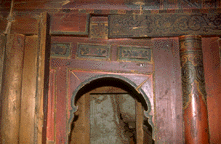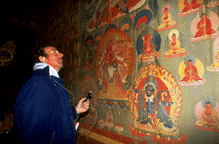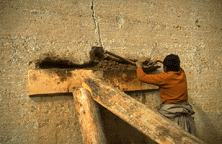 |
| Damaged woodwork at Palpung. |
Trees have closed in over our heads, and the night is the blackest I've ever seen. The only sounds are the roar of the Baiqu River invisible to my left, and the tinkling bell of my Tibetan pony. I think of Robert Frost's lines: "The woods are lovely, dark and deep; but I have promises to keep; and miles to go before I sleep; and miles to go before I sleep." All true. Baiya Monastery lies an hour or more ahead, and I, as CERS's representative on our project to restore Tibetan monasteries in western Sichuan, will have many promises to keep when we get there.
Today our expedition got a late start, for our horses did not arrive at the rendezvous point until nearly sunset. The Tibetans who are accompanying us are undeterred by darkness; they know the trail well and, anyhow, horse's eyes are better than man's. Perhaps it's better that my two charges, British conservation architect John Sanday and his Nepalese assistant Razat, can't see the precipices on whose edges they tread. If they could I fear they would turn back before our work has even begun.
To repair and conserve the Tibetan monasteries of Baiya and Palpung are the reason for this long journey, although in the travails of getting here--first by airplane to the Sichuan capital of Chengdu, then bus, van, truck, and now horseback--I haven't had time to think of the purpose of our journey. But now that Baiya Monastery grows closer every minute, I look forward to beginning our real work at last.
 |
| John Sanday inspects damaged murals at Baiya Monastery |
The trees open to reveal a veil of stars--astonishingly numerous and brilliant at this elevation, more than 3400 meters above sea level. I have traveled this way before, and know that the absence of trees means we are crossing the barley fields immediately adjacent to Baiya Gonpa. Almost there!
Now we cross a fast, cold stream and mount a hill. The horses bunch, and I see the lead man's flashlight playing along the side of a great ocher-colored clay wall. It's as if Baiya has come leaping from my memory banks to materialize out of the blackness--a grand wizard's trick, but I'm too tired to think of that now. Burgundy-swathed monks come to lead the horses into the courtyard and to carry our bags upstairs.
In a plain, plank-walled room we quickly inhale the bowls of tea they pour for us, wolf down some tsampa (barley flour) and freeze-dried stroganoff, then fall into bed.
Next morning John and Razat begin the work of inspecting Baiya Monastery. The building, although more than two hundred years old, is small and no great architectural treasure in and of itself. The reason for CERS's interest is that it houses one of the finest sets of murals in western Sichuan. It is to save these priceless murals that we are undertaking to repair the building.
Actually "repairing" is a misnomer; we are "conserving" Baiya. As John frequently reminds me: "If you can find a way to keep as much of the original timber as possible, you save money and you save history." His job is to do this while reversing the effects of decades of neglect. We also hope to solve some problems intrinsic to Tibetan buildings such as inadequate interior ventilation and poor roof drainage. Another consideration is earthquake resistance, since western Sichuan is a seismologically active area; a quake of greater than magnitude five hit just last year.
 |
| John Sanday directs installation of a "stitch" in the side of a building to stabilize movement of a crack. |
Steadfastly ignoring the clear blue sky, warm autumn sun, and beckoning mountain vistas, John and Razat prowl around Baiya's roof, their faces turned downward. Its complicated two-tiered design of layered mud and wood seems at first inscrutable, but John doesn't need long to diagnose Baiya's trouble: "The problem with these buildings is that they're always overladen. They put too much clay on to stop the water going through." Our plan of action is already clear. John explains: "Most important is to reduce the [roof's] weight. Then we put in a polythene sheet to stop the water going through. We'll have to remove the paintings, repair the roof, then refix the paintings. This is a specialist job."
We don't have a mural specialist on hand, but there is plenty to be done before we bring one on our next visit. Razat gets busy drawing cross-sections and digging holes in the roof to discover how thick the clay really is and what lies underneath.
The murals in the lower hall, luckily, are not so marred by crumbling mud plaster and are well distanced from the roof; they will remain in place while the building is repaired. Despite age and dirt, their craftsmanship is still striking--magnificent. This part of the Tibetan plateau once belonged to an independent kingdom called Dege, which was renowned for the fineness of its Buddhist art. Dege fostered a whole school of Buddhist painting, but few examples survived the Cultural Revolution. Among those few survivors, Baiya's murals have no rival; they depict not only the usual pantheon of Buddhist deities but also the opulent court of Dengba Tsering, a great 18th-century Dege tushi (king).
Four days later our notebooks are packed with notes, drawings, and a work plan for the next five months. It is time to be on our way, to Palpung Monastery. The half-day ride along the Baiqu's banks is sunny and uneventful, culminating with a 200-meter climb to a rocky prominence on which stands the immense fortress of Palpung Gonpa.
 |
| John Sanday inspects drainage on Palpung's roof. |
After homey little Baiya Monastery, Palpung seems a giant. Its huge walls loom up as we approach, and its labyrinth corridors and countless rooms--all shaken and twisted out of their proper shape by last year's earthquake--make us feel Lilliputian indeed. Even John, who has worked on some of Asia's greatest archeological treasures, is daunted: "This is a mammoth, mammoth task," he says on the first day. "At the moment all we're doing is irritating the elephant--a little gnat scratching at its side."
Exploration reveals a plethora of leaning columns, separating joists, and crumbling walls. At first John is baffled. "There's no logic that I can work out as to the movement of the building that has taken place. One floor is going one way, the next floor is going the other," is his early lament. Then, systematically, he excavates mud around the base of some columns and discovers rotted wood that is slowly collapsing and skewing the whole structure. One by one, pieces of the puzzle fall into place.
After consultation with Xiong Xiong, a local Tibetan who will oversee the work, we decide that Palpung will be easier to handle if we divide the building into parts. In each part we'll replace rotten timber, and do some leveling and straightening, but not interfere too much. "This is a great example of the value of leaving well enough alone," says John. "You can jack things up here and there, but you're not going to get true horizontal and true vertical. In most cases you've just got to accept [the deviations]."
By now, after nearly two weeks on the high plateau, I feel almost at home here, and my
body is thriving on a rich diet of butter tea, yak meat, tsampa, and fresh mountain
air. But our mission is finished, and its time to leave this mountain paradise for the
mixed blessings of civilization. Yet already we're thinking ahead to next year, to the
time that we'll return to keep our promises to Baiya and Palpung Monasteries.